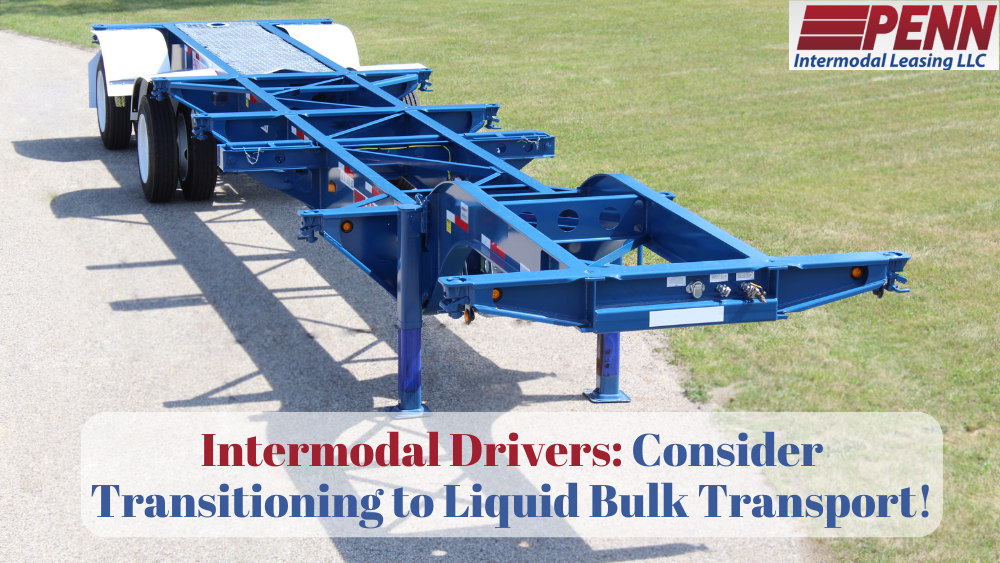
Transporting liquid bulk products offers steady work, higher rates, and greater industry diversity for truck drivers. Explore the basics about what you need to know to transition to this rewarding field, including required certifications, equipment you’ll use, and the industries that rely on bulk liquid transportation.
Why Transition To Transporting Liquid Bulk Products?
There is a growing demand for truck drivers who can transport liquid bulk products. This niche field also comes with higher compensation for intermodal truck drivers. The bulk liquids market is expected to grow to $76.93 billion in 2027 at a CAGR of 6.7 percent creating employment options for intermodal truck drivers. (“Bulk Liquid Global Market Report 2023”). Transporting bulk liquids allows truck drivers to enjoy:
- Less competition
- Greater compensation in both salary and benefit packages
- Less strenuous loading and unloading
- Greater work-life balance with shorter routes and less time away from home
What Industries Use Liquid Bulk Products?
Common types of bulk liquid products include: chemicals, dairy and edible oils, and petroleum products. The transport of these materials is critical in the following industries:
- Agrichemical
- Petroleum
- Chemical
- Environmental Services
- Food
- Pharmaceuticals
Requirements For Transporting ISO Tank Containers Vs. Intermodal Containers
Training and Education
All truck drivers including drivers who transport ISO tank containers or intermodal box containers are required to have a commercial motor vehicle license (CDL) obtained by attending a CDL training program or truck driving school. Additionally, it is recommended that all truck drivers hold a high school diploma or a GED.
Certifications and Licenses
CDLs are divided into three classifications:
- Class A: Permits the driver (in most states) to operate a semi-trailer or trailer with 2 or more axles and a GVWR of 26,000 or more pounds. Required when the towed vehicle is heavier than 10,000 pounds.
- Class B: Permits the driver of vehicles with a GVWR of 26,000 or more pounds, but limits the towed vehicle to less than 10,000 pounds.
- Class C: vehicles that are designed to transport 16 or more occupants or transport hazardous materials (HazMat) with the proper endorsements.
ISO tank container truck drivers also need to acquire special licensure endorsements that allow them to haul specific types of liquid or gas freight.
- H Endorsement: hazardous materials (optional).
- N Endorsement: liquids or gasses (required).
- X Endorsement: combination endorsement for tank vehicles and hazardous materials (recommended).
Other Requirements
Additional requirements for ISO tank container truck drivers include:
- Passing an eye exam
- Passing the tanker endorsement exam from the Federal Motor Carrier Safety Administration (FMCSA), DOT
What Equipment Is Used For Liquid Bulk Transport: Tank Chassis
The primary equipment used for hauling liquid bulk products are Tank Chassis with Tank Containers also known as “combo units.” These are a type of intermodal chassis.
ISO Tank Chassis vs. Chassis for Hauling Shipping Containers
ISO tank chassis are engineered differently than dry box chassis. Intermodal tank chassis are designed with greater stability. A lower deck height provides a lower center of gravity, which is critical for loads that are more prone to shifting. These uniquely designed tank chassis significantly improve bulk liquid transport safety and reduce the potential for rollovers.
Intermodal tank chassis are available in several drop frame configurations including:
- Spread-Axle,
- Tri-Axle,
- Hi-Lo, and
- Closed-Tandem models.
Types of ISO Tanks:
An ISO tank container is a vessel used for the transport and storage of liquid or gas products. ISO tank containers are most often constructed from stainless steel and enclosed in a 20’ ISO tank container frame. These tanks can feature several options for liners, insulation, and protective coatings such as aluminum or polyurethane. Common ISO tank container categories include:
- T-11s designed for general chemical storage or transport and fabricated to hold the following quantities:
- 5,547 gallons
- 6,340 gallons
- 6,868 gallons
- T-22s designed for highly hazardous products and fabricated to hold the following quantities:
- 3,830 gallons
- 4,623 gallons
- 5,547 gallons
- T50s designed for high-pressure liquefied gasses and fabricated to hold the following quantities:
- 6,419 gallons (34.4 bar)
- 6,498 gallons (22 and 27.5 bar)
Advantages of ISO Tank Containers: Safety and Integrity
- Less prone to damage or punctures
- Provides a high level of product integrity
- Provides the benefits of intermodal transport for liquid products
- Convenient and economical storage
- Lower risk of leakage than drum storage
- Requires less handling than drums
- Lower transportation costs for long-haul freight
What Other Equipment Is Used For Liquid Bulk Transport: Tank Trailers
MC307/DOT407s are the primary choice for transporting mild acids and low-pressure liquids such as solvents and organic chemicals.
MC312s/DOT412s are designed to carry volatile and corrosive chemicals and acids. These trailers are often modified with tank liners and other features to preserve equipment integrity while transporting these types of chemicals.
MC331 carbon steel tankers transport liquid propane and other high-pressure gasses. These vessels are constructed to hold up to 11,500 gallons and operate with high-volume pumps for efficient off-loading.
Equipment Requirements
The equipment used in intermodal tank transport is subject to several safety protocols, inspection, and maintenance. The most common include:
- Mandatory routine inspections
- Cleaning, sanitation, and routine maintenance
- Pneumatic leak tests
*This is not intended to be a comprehensive list, but to provide an introduction and improve industry awareness for drivers considering the liquid bulk market.
Choose Penn Intermodal Leasing for Liquid Bulk Transport Equipment
Contact Penn Intermodal Leasing, LLC to learn more about intermodal tank chassis leasing. With over 30 years of experience, our team of experts can assist you in outfitting your fleet with the industry’s best equipment for bulk liquid transportation.
Sources
- “Bulk Liquid Global Market Report 2023.” GlobeNewswire, 24 February 2023. Accessed 14 February 2024.
- “CDL Endorsements and Restrictions.” Driving-Tests.org, . Accessed 15 February 2024.
- “What is a tanker endorsement for a CDL and when do you need one?.” Schneider,. Accessed 14 February 2024.

